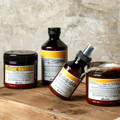Free Carbon Neutral Shipping On Orders $75+, Plus Free Samples!
Buy Now and Pay Later in 4-interest free installments with Klarna
Free Carbon Neutral Shipping On Orders $75+, Plus Free Samples!
Buy Now and Pay Later in 4-interest free installments with Klarna
Rendre la beauté durable
We Are Circular
Ajouter une description, des images et des liens au méga menu
Une colonne sans paramètres peut être utilisée pour créer un espace.
Lien vers vos collections, vos ventes et même des liens externes.
Tried & True Favorites to Protect Your Salon Color
Welcome to the ever-changing world of haircare, where the rules are meant to be broken and the trends are tough to keep up with. It can be exhausting, right? Well hold on tight, because we’re about to flip the script (literally) again. But trust us, this one’s worth it. First, picture your regular shampoo/conditioner routine—but reverse it. That’s the basic concept of the latest hair cleansing method, reverse hair washing. Instead of shampooing first, you apply conditioner first, followed by a gentle shampoo cleanse. It’s particularly beneficial if you have fine, damaged or overly-processed hair. Why, you might be asking? And who else can benefit from this method? We’re unpacking the details here.
We all know that no two heads of hair are alike. Each person’s hair is a unique and complex ecosystem. So why throw traditional cleansing methods—that have worked for us for years—out the window? Maybe this will convince you.
Reverse hair washing works in harmony with your hair’s natural structure, preserving its oils and maximizing the benefits of conditioning. When you start with conditioner, you create a ‘barrier’ shielding the hair shaft from damage during cleansing. Not only that, but the conditioner also helps detangle and soften the hair, making it more resilient to the shampooing process that will come next. Additionally, conditioners can leave the hair feeling limp and weighed down, especially when you fail to rinse them out completely. When you reverse the steps and shampoo at the end, you’re ensuring a thorough cleanse.
The main idea with reverse washing is that your locks will get the benefits from a conditioner—i.e. moisture and nutrients that enhance natural shine—but because you’re cleansing afterward, your hair won’t be weighed down by its heavy ingredients. Read: the shampoo will rinse that all away.
While most hair types can benefit from reverse washing, it’s particularly advantageous for those with fine, oily or thinning hair as it can improve volume and help the hair look fuller, softer and shinier—mostly because it’s no longer weighed down by a heavy conditioner. If you have coarse, curly or thick hair though, take caution. Alternative methods like co-washing, ultra hydrating hair masks and deep conditioning hair treatments may be more beneficial.
This method of hair washing couldn’t be easier. Sure, it’s different than the tried-and-true way we’re used to, but reverse washing is just as simple—except reverse. Here’s the step by step breakdown.
First, wet your hair as you normally would. Lukewarm-to-warm water is the sweet spot (as opposed to scalding hot water as I often prefer when showering!) as it enhances product absorption.
Apply a good amount of conditioner, mid-strand to ends, avoiding the roots and scalp as much as possible. All conditioner does for the scalp is cause grease and potentially breakouts. Allow the conditioner to work its magic for a few minutes. This step is key—so be patient while the conditioner sets.
While the conditioner is in your hair, take a minute to detangle your strands. A detangling brush is perfect for this step. Then thoroughly rinse using lukewarm water once again.
Next, apply a small amount of shampoo, focusing on the scalp down to the mid-shaft. Gently massage the shampoo into the scalp to help wash away buildup. If you’re in the market for a gentle, yet moisturizing shampoo, this one is a fan favorite. One tip—don’t scrunch and mess with your hair too much while cleansing or it can cause tangles.
Finally, give the shampoo a good long rinse using (you guessed it) lukewarm water. Squeeze out any excess water, then dry it off using an absorbent microfiber towel. Avoid messing with your hair too much once again, or else the dreaded ‘f’ word may occur. Frizz. Then voila, you’ve just reverse washed your hair.
If you normally wash your hair four times a week, you can reverse wash your hair four times a week. It’s a different order, but it’s still cleansing and conditioning. That said, everyone is different, so it may take a few days of experimenting to figure out the best cadence. For instance, you may find that this method allows you to go a little longer between washing. Or, you may discover that swapping to a reverse wash 50% of the wash days is better than 100% of them. You know your hair, so you know best.
Our goal is more “wow your hair looks amazing” moments—because when our hair looks fabulous, we feel fabulous, and switching to a reverse hair washing routine is just another way to achieve that. So try it for yourself, and if you need product recommendations on your journey, find a stylist in your area to consult with.
by Morgan Hanson, featured contributor
S’abonner pour rester à l’affut des ventes et promotions, les lancements de nouveaux produits et bien plus…
Abonnez-vous à notre newsletter pour bénificier de la livraison gratuite sur votre première commande.
La soumission de ce formulaire confirme que vous acceptez de recevoir les avis de lancement, les promotions et les nouvelles marketing de Davines North America Inc. par courriel.




Laisser un commentaire
Les commentaires sont approuvés avant leur publication.